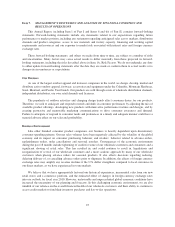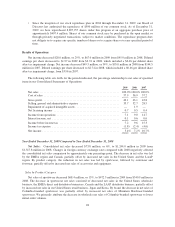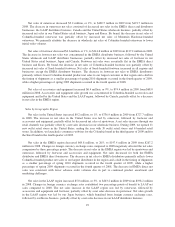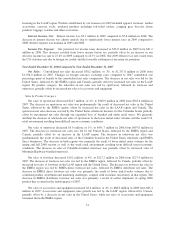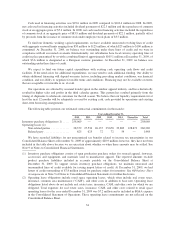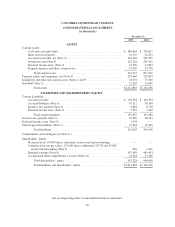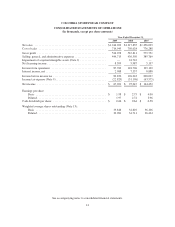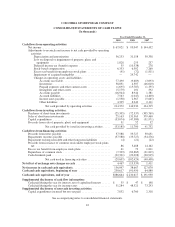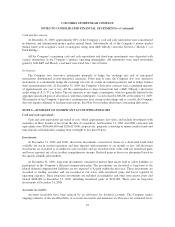Columbia Sportswear 2009 Annual Report Download - page 42
Download and view the complete annual report
Please find page 42 of the 2009 Columbia Sportswear annual report below. You can navigate through the pages in the report by either clicking on the pages listed below, or by using the keyword search tool below to find specific information within the annual report.Quantitative and Qualitative Disclosures About Market Risk
In the normal course of business, our financial position and results of operations are routinely subject to a
variety of risks, including market risk associated with interest rate movements on borrowings and investments
and exchange rate movements on non-U.S. dollar currency denominated assets, liabilities, income and expenses.
We regularly assess these risks and have established policies and business practices that should result in an
appropriate level of protection against the adverse effect of these and other potential exposures. We do not
engage in speculative trading in any financial market.
Our foreign currency risk management objective is to mitigate the uncertainty of anticipated cash flows
attributable to changes in exchange rates. We focus on anticipated cash flows resulting from firmly and
non-firmly committed inventory purchases and the related receivables and payables, including third party or
intercompany transactions.
We manage this risk primarily by using currency forward, option and swap contracts. Anticipated, but not
yet firmly committed, transactions that we hedge carry a high level of certainty and are expected to be recognized
within one year. We use cross-currency swaps to hedge foreign currency denominated payments related to
intercompany loan agreements. Hedged transactions are denominated primarily in European euros, Canadian
dollars, Japanese yen and Korean won.
The fair value of our hedging contracts was unfavorable by approximately $0.4 million and $1.8 million at
December 31, 2009 and 2008, respectively. A 10% change in the euro, Canadian dollar, yen and won exchange
rates would have resulted in the fair value fluctuating approximately $9.7 million at December 31, 2009 and $6.2
million at December 31, 2008. Changes in fair value resulting from foreign exchange rate fluctuations would be
substantially offset by the change in value of the underlying hedged transactions.
Our exposure to market risk for changes in interest rates relates primarily to our debt obligations. We did
not have any long-term debt obligations at December 31, 2009 or 2008. We have cash flow exposure on our
committed and uncommitted bank lines of credit since the interest is indexed to various reference rates such as
Prime and LIBOR. At December 31, 2009 and 2008, our bank lines of credit did not have an outstanding balance.
Critical Accounting Policies and Estimates
Management’s discussion and analysis of our financial condition and results of operations are based on our
consolidated financial statements, which have been prepared in accordance with accounting principles generally
accepted in the United States. The preparation of these financial statements requires us to make various estimates
and judgments that affect reported amounts of assets, liabilities, sales, cost of sales and expenses and related
disclosure of contingent assets and liabilities. We believe that the estimates, assumptions and judgments involved
in the accounting policies described below have the greatest potential impact on our financial statements, so we
consider these to be our critical accounting policies and estimates. Because of the uncertainty inherent in these
matters, actual results could differ from the estimates we use in applying the critical accounting policies. We base
our ongoing estimates on historical experience and other various assumptions that we believe to be reasonable
under the circumstances. Many of these critical accounting policies affect working capital account balances,
including the policy for revenue recognition, the allowance for uncollectible accounts receivable, the provision
for potential excess, close-out and slow moving inventory, product warranty, income taxes and stock-based
compensation.
Management and our independent auditors regularly discuss with our audit committee each of our critical
accounting estimates, the development and selection of these accounting estimates, and the disclosure about each
estimate in Management’s Discussion and Analysis of Financial Condition and Results of Operations. These
discussions typically occur at our quarterly audit committee meetings and include the basis and methodology
used in developing and selecting these estimates, the trends in and amounts of these estimates, specific matters
affecting the amount of and changes in these estimates, and any other relevant matters related to these estimates,
including significant issues concerning accounting principles and financial statement presentation.
35


